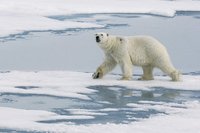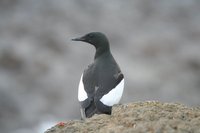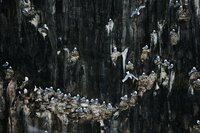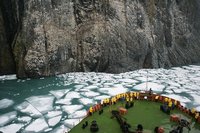The geographic North Pole is in the middle of the Arctic Ocean under ice that's about 10 feet (3 meters) thick, so anything that lives there is typically more aquatic. No known amphibians or reptiles live in the Arctic tundra and polar region, but approximately 20 species of mammals live there. Among the few land animals that migrate to the region are caribou (reindeer) and the arctic fox. The aquatic mammals are beluga and killer whales, sea otters, ringed seals and walrus.
Polar bears also hang out around the North
Pole. Bears swim up to 100 miles, eating
mostly seals and never hibernating except
for the female which does take a long rest
when she has her cubs. Arctic trekkers are
most likely to encounter polar bears on their
journeys because the bears are naturally
curious - and attracted by human food. Polar
bears are increasingly seeking out humans,
especially the Inuits who live in the area,
because the melting polar ice is shortening
the bears' hunting season. So, the bears
have to forage for food in new areas that
are often occupied by humans. As the North
Pole gets warmer, polar bears and other animals
are facing extinction.
Recorded sightings on our trip were:
Polar Bears, Ringed Seal, Bearded Seal, Atlantic
Walrus, Humpback Whale, Northern Minke Whale,
unidentified dolphin species.
Birds
Approximately, 100 bird species live in the
Arctic tundra and polar region. Arctic birds
usually spend their winters farther south
in the tundra region, but the puffin, albatross,
bald eagle, peregrine falcon, ptarmigan,
jaeger and snowy owl can all be found in
the Arctic.
World Traveller - The tern, measuring in at 11 to 15 inches long, migrates
from the Arctic to the Antarctic during the
Northern Hemisphere's winter. That's
a trip around the world every year.
Recorded sightings on our trip were:
Red-Throated Diver, Northern Fulmar, Common
Eider, Purple Sandpiper, Pomarine Skua, Arctic
Skua, Glaucous Gill, Black-legged Kittiwake,
Ivory Gull, Arctic Turn, Little Auk, Brunnich’s
Gillemot, Black Guillemot, Atlantic Puffin,
Snow Bunting.
Fish
There are 400 known fish species swimming
in the Arctic Sea, with the most common fish
near the North Pole being the arctic cod.











.JPG/img/IMG=_4606(edited)-thumb-200x200.JPG)
.JPG/img/IMG=_4608(edited)-thumb-200x200.JPG)
.JPG/img/IMG=_4612(edited)-thumb-200x200.JPG)

.JPG/img/IMG=_6683(edited)-thumb-200x200.JPG)

.JPG/img/IMG=_7141(edited)-thumb-200x200.JPG)

